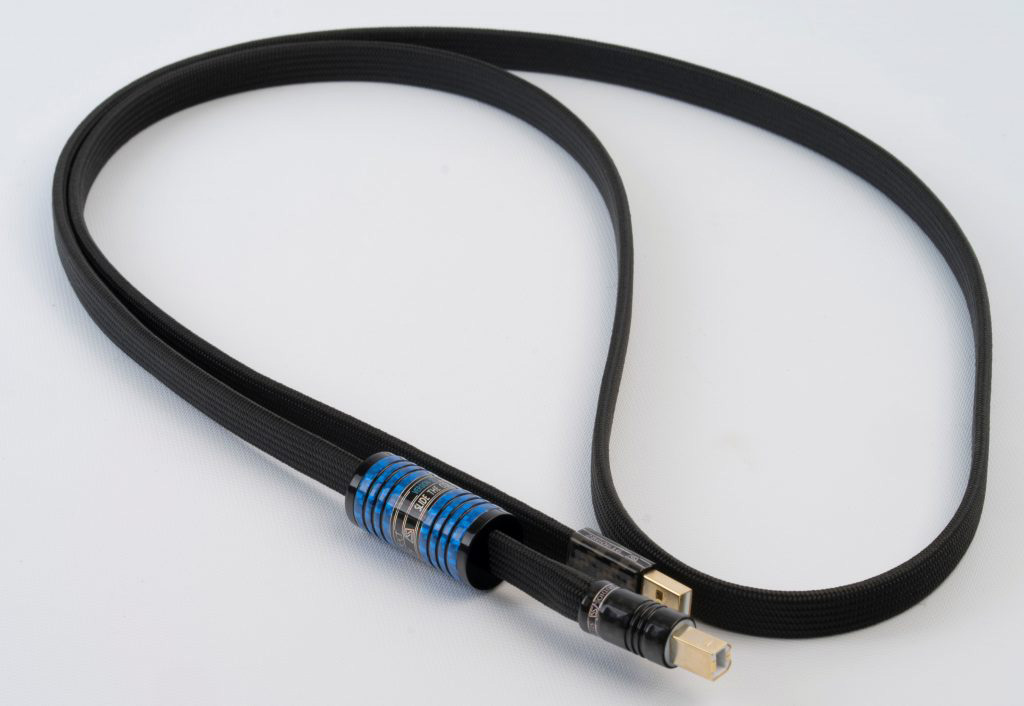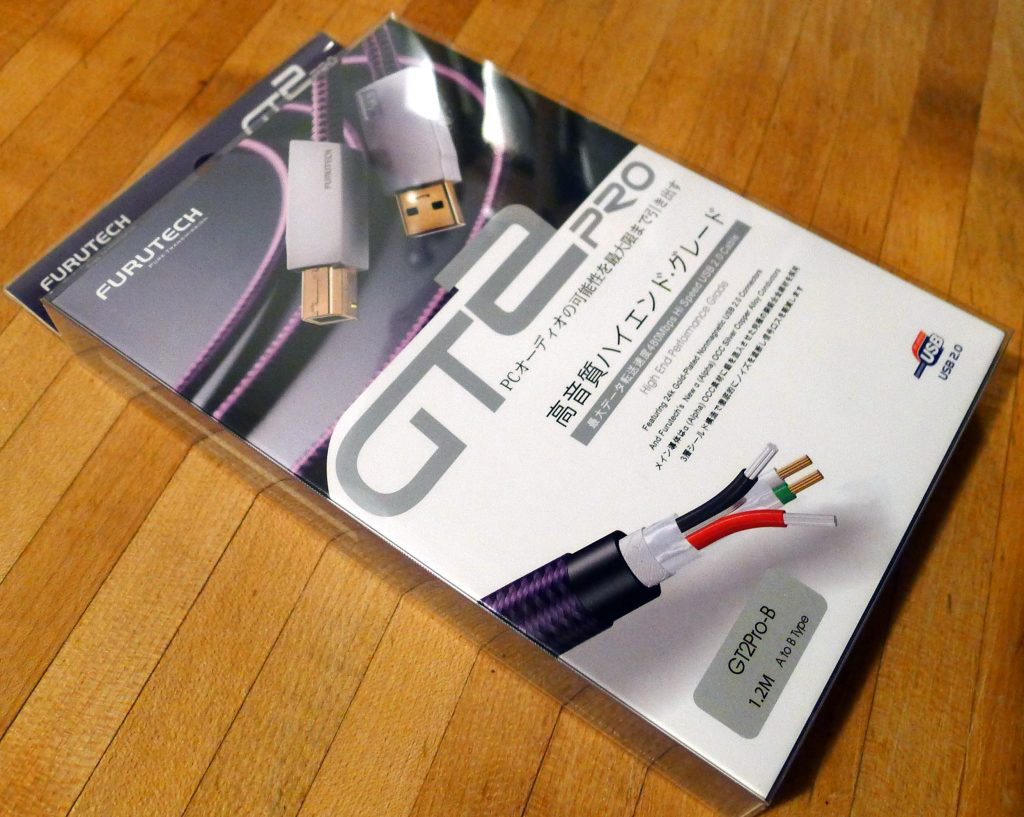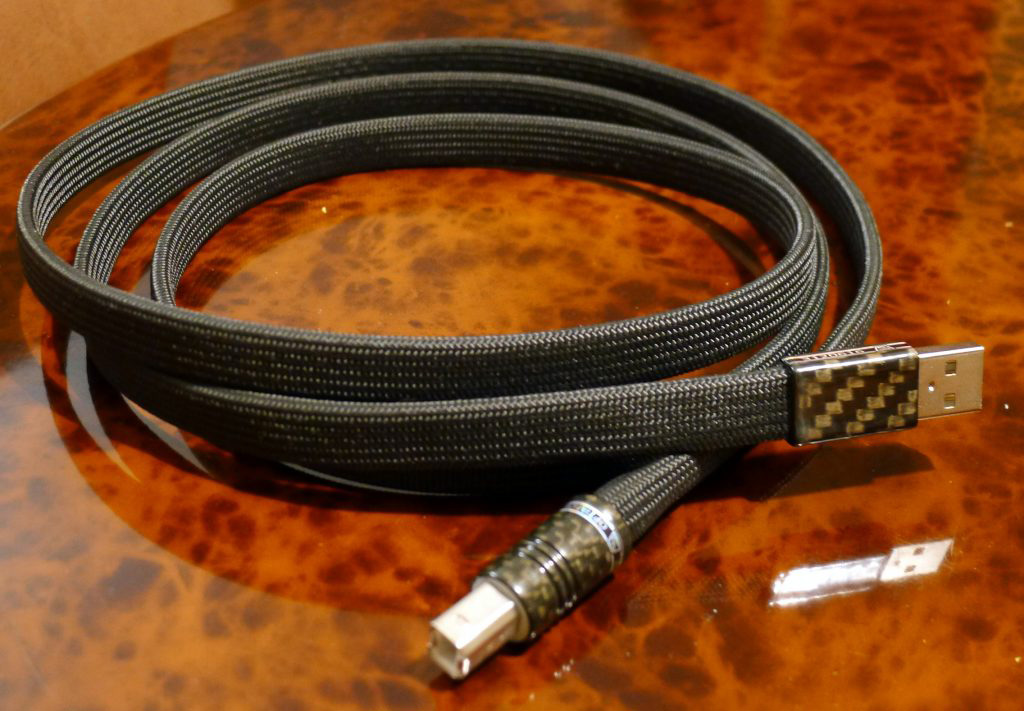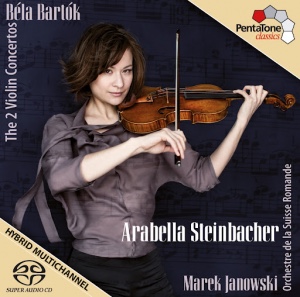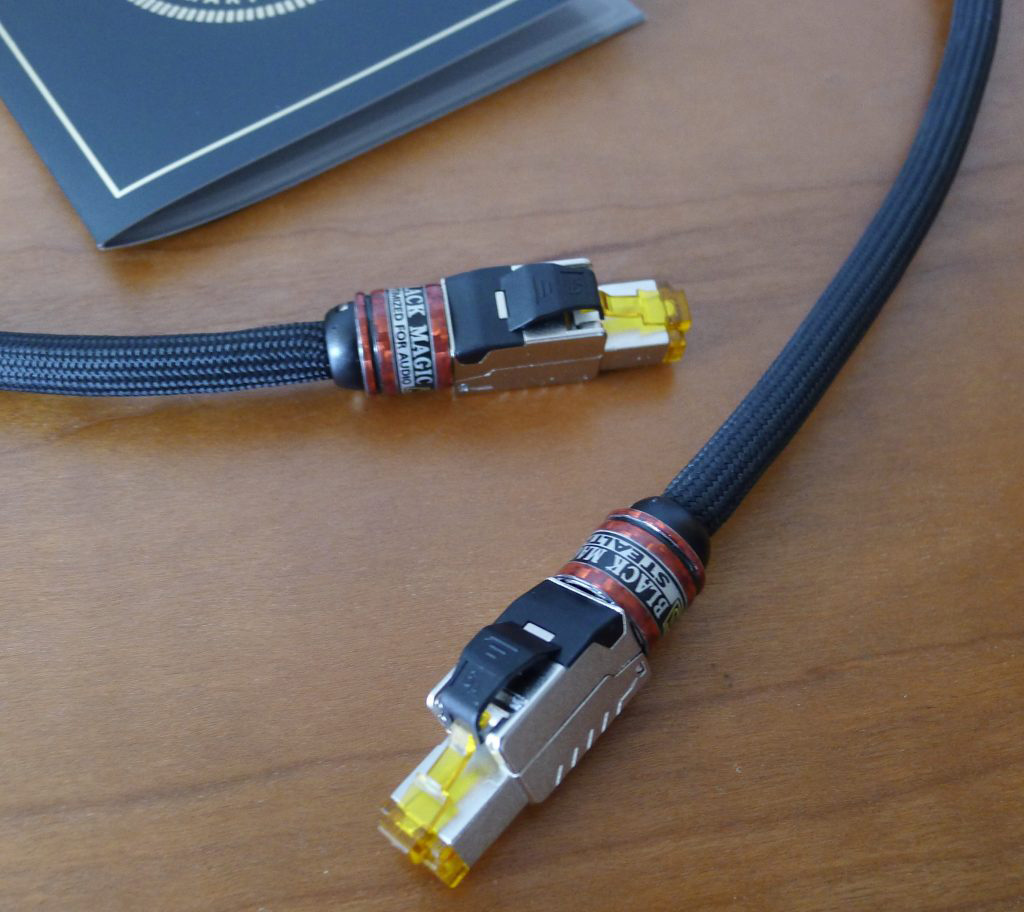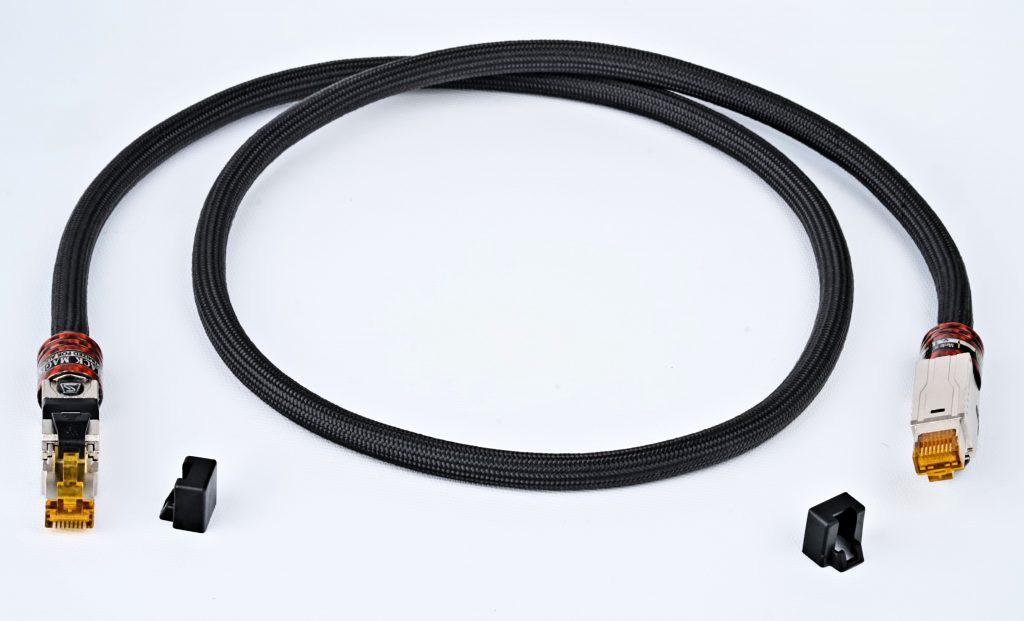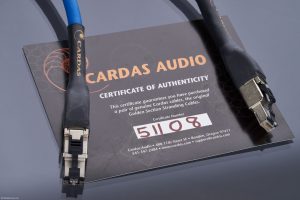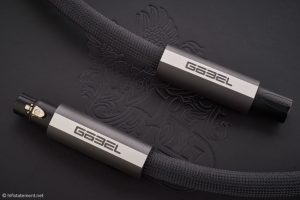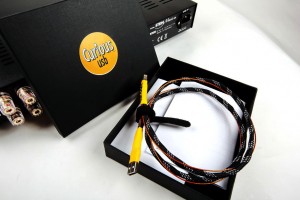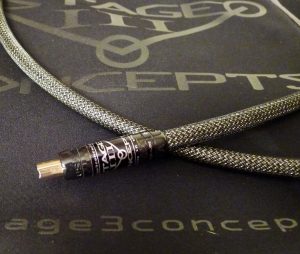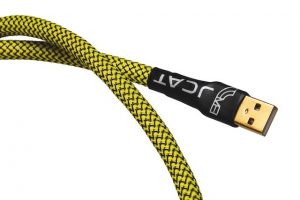A Google search found the pugilists in their corners sparring over USB and Ethernet cables, just as they do over interconnects and speaker wires. Being very new to the music server scene, I somehow thought things would be different, that maybe we had gotten beyond that.
It's irksome to me that so many in the "cables-don't-make-a-difference camp" have never tried the products they're dismissing. They're coming from a theoretical point of view—that will always land you in hot water. Second point of irritation: many of the naysayers appear to have modest rigs with components incapable of revealing differences. Sure, everybody is entitled to an opinion, but what's the value here? I haven't the patience for it.
USB Streaming
Before I compare a couple of USB wires, here's a quick rundown of my front-end, since results are very situation specific with music servers. I use Roon on my MacBook Pro laptop and iPhone for music management because its user interface and meta data presentation is considered the best by many in the industry. A Furutech GT2Pro USB cable takes the bitstream to the USB plug-in on my CH Precision C1 DAC. The Furutech was recommended to me as well-balanced, tilting neither to the musical nor analytic side, and that's how I find it. It just does its job, gets out of the way, and got me started at a very affordable price ($320/1.2m). Music files are stored on a 4TB WD My Book hard drive attached to the laptop via its own USB.
Furutech GT2Pro USB
In brief, this front-end impresses by the total absence of the distortions and artifacts commonly heard in home audio. The sound is full range: bass is well-represented, and the treble is extended without etching. Dynamic range is expansive with satisfying macros that are as clean as a whistle. The presentation fills up the front of my room with good width, although depth is shallow.
Thinking about what I've got here, it strikes me that I've heard some variation of it many times before. That list of virtues is what you hear in room after room at demos of music server front-ends, which leads me to speculate it may be fairly easy to achieve a basic, good sound with server front-ends. After all, I just slapped these parts together (with some guidance from my friends at CH Precision) and it came out that way. With vinyl or CD, you don't capture these virtues so easily, you have to work at taming the gremlins.
That is not to say it is without shortcomings, however. My main complaint is the lack of variety in the sound, the heavy footprint. There is a good deal of "carry-over" that makes instruments sound the same. (The opposite would be one that treads lightly, where differences are exposed.) Interesting: I'm using a hi-res source (DSD 64), but it doesn't seem to factor in. There's a blockage somewhere and the extra density is not being reproduced. Upon further reflection, it strikes me this, too, is a shortcoming common to many low-to-mid-level server demos.
I was thinking about blockages and my eye unconsciously went over to the USB cable. My next stop was the internet to do some research about wires and that's when the combat zone came right up. Really? So I decided to scale-up my cables and see what's what.
Replacement Parts:
the STEALTH Audio USB
"Yes, certainly, I will send you our USB cable," Serguei Timachev, the STEALTH Audio designer, emailed me. "Same shipping address as before?"
"I've been at the same Manhattan address for 35 years and I will meet my demise here. Only the rich can afford to move in NYC." Soon the first upgrade arrived, a STEALTH USB cable (MSRP $850/m).
After a three day burn-in, I'm ready to listen. I cue up Bartok: the Two Violin Concertos, with Arabella Steinbacher (Pentatone 5186350, a DSD 64 file). Two adjectives come quickly: TEXTURE and SPACE. On the former, it's obvious we've gotten a new prescription from the audiologist: drastic corrections for low-level resolution and blurriness have been applied. With these improved aural goggles the weave of the sonic cloth can be glimpsed and you can follow Steinbacher's violin with no difficulty. You start to pick up how she spins the score to make it her own. The STEALTH USB removed a good deal of the blockage and pushed down the heavy carry-over.
The prescription profoundly alters the low-end, although the tonal balance has not changed. No more squishy, Jello-like substrate, your feet are planted on terra firma, the foundation below them is solid and supportive. The instruments that play in the low register come into view as separate images, each one distinct, so the bass drum detaches from the double bass string section, and is clearly pitched below them.
Space is in my thoughts because depth, the third dimension, is now in play. The flat painting of the soundscape has shapeshifted into a virtual 3-D sculpture, with images hanging at specific coordinates. Finally, it's evident dynamic range is wider, even as stress-free crescendos are maintained. All of this was hazily hinted at with the Furutech, but not clear. It's like the difference between a chaotic mob scene and an organized demonstration.
Ethernet Streaming
Moving over to Ethernet, my setup consists of a long cable from a Verizon FiOS router to a gigabit Ethernet switch by my audio rack, plus two short CAT 7 Ethernet cables—one going to the CH Precision C1 DAC, the other to the MacBook. All of these were bought at a local electronics store. (For those curious, the latest Ethernet HD upgrade is installed on my C1 DAC.) Roon was again used for music file management.
I cued up the Bartok Violin Concerto #2 and proceeded to take this front-end's number. Wouldn't you know, when I look at my issue list it almost repeats my experience with the Furutech USB. This was surprising, given the vastly different signal paths.
The harp enters on the far left followed immediately by the French horns. As with USB, I notice, or rather, I fail to notice, much difference in the timbre, dynamic action, and imaging of these two very different instruments. Soon the lower strings enter; they also have similar characteristics, just lower in pitch.
Spatial cues are not well-formed and depth is truncated. That causes image smack up and smearing. When Steinbacher enters, unfortunately, it's the same. When she plays fast—I can't make out the runs. The full orchestra joins in and the double basses coagulate with the cellos. You get the picture—it's like low-res TV.
The biggest differences from USB are 1) Ethernet is noticeably SOFT! The rounded transient, the long decays, the amorphous space… 2) Ethernet is noticeably more airy, with big gains in liquidity and flow.
Replacement Parts
the STEALTH Black Magic Ethernet Cables
Quick, let's insert the STEALTH Black Magic Ethernet cables (MSRP $1300/m), after a three day burn-in. Again, the changes in the sound-picture parallel when we put in the STEALTH USB, perhaps not surprisingly when you think about it. There is a consistency in what these STEALTH wires do. The mass of harp and French horns separate to discrete locations on the left side of the stage, while the low strings move to the right side. Each instrument is granted its own space and independent action: the harp is plucked, the French horns play sustained notes, and the low strings are pizzicato. Although it is still soft, it is not as big an issue as it had been.
Both STEALTH USB and Ethernet cables account for an expansion of the tonal/timbral palette, but the Black Magic Ethernet cables take it a step further, so when Steinbacher makes her entrance it is thrilling. The richness of the instrument's tone and timbre, coupled with the newly granted resolution of her line, create a close-up, almost intimate encounter. Very beautiful; very moving; she is a great artist and I am connecting with her statement in an emotional bond. This is important: I need to reinforce this point.
What is it about her playing that's so alluring? Consider the complexity of an instrument's sound, what is often called its sound envelope. It has a transient, sustain, and decay. Audiophiles talk about the speed and quality of the onset, how soon the note attains steady state and its duration, and the length and quality of its dissipation. But that's just a starter: there's a lot more going on in the sound envelope we should be talking about.
Timbre, for one, needs to be in the discussion; its importance is on par with any other gradient. Assuming a quality recording that captures what the artist delivered (another variable), it is up to the reproducing system to (hopefully) play it back. Components, and cables, can be good or deficient at this. When I put in the Black Magic cables, the texture, inner details, and especially the timbral colors of Steinbacher's instrument poured forth like a fountain and washed over me. After decades of concertizing, I'm keenly susceptible to the allure of this sensory spray, the tingling sensation of data that coalesces into a beautiful sound—and this is what hooked me when I put in the Black Magic cables.
Now, I know audiophiles who never discuss timbre or talk about the beauty of a performance. Their priorities lie elsewhere. My take is they're missing something major. Isn't this whole endeavor supposed to be about recreating the sound of unamplified acoustic instruments in a good hall?
In my particular configuration with the STEALTH cables loaded, Ethernet clearly beats USB. Believe me, I would never entertain going back to those $17 off-the-shelf Ethernet cables again.
Design and Construction
A short statement from the manufacturer:
Our STEALTH USB cables are flat in cross-section and reasonably flexible. The conductive material is a proprietary copper-based alloy. The connectors, also proprietary, use carbon fiber shells.
From a technical standpoint, USB cables can sound different for two simple reasons. High-frequency noise, generated by the source (which is usually a PC of some sort) gets into the digital-to-analog converter circuitry and 1) messes up the conversion to analog; 2) messes up the analog amplification that follows the conversion. Filters to block the noise are difficult to implement because the ground plane is just as polluted as the signal path.
For engineers and highly technical audiophiles, if you were to use a spectrum analyzer to look at the high-frequency noise that goes though an off-the-shelf cable, other high-end USB cables, and our cable, you would indeed see a difference. STEALTH USB cable is specifically designed to be bandwidth limited. The tricky part (actually, the ART of the design) is to get rid of the most of the noise, but leave the signal intact.
Our Ethernet cable has gone through many iterations. The Black Magic V18 and V19 are a proprietary version of CAT7 (we may call it CAT7+). The newly developed V20 may best be called CAT 7++.
The V20 incorporates special measures for better separation (lower crosstalk) between the four twisted pairs inside. On top of that it uses better Rj-45 connectors and better termination technique. All of these make an audible difference.
A Discussion about Computer Noise
Much of the discussion online concerns computer generated noise. As Serguei says, it gets into the D to A conversion and compromises the signal, then gets amplified in the analog section. How is the noise manifest in the machine? What does a listener hear?
Here's a trick question: Do you believe you can hear the computer's artifacts as actual noise? I ask this because I don't—and you can't either. The inconvenient fact of the matter is the noise artifacts we're talking about are not in the human hearing bandwidth; it is very high-frequency, in the megahertz and even gigahertz region. Yet, you read article after article stating "…the xyz music server was swapped in and the noise level plunged." It makes you wonder—what did they hear they are calling noise? No doubt servers sound different, but actual audible noise has not been an issue in digital for many years. (By comparison, I hear true noise frequently with analog.)
I polled my technical resources to get a better understanding. The first distinction to be made is whether the computer's artifacts are coming in on the clock signal or the data, as these would impact differently. If added to the clock signal it would have an effect similar to jitter and compromise timing. If added to the data signal it could cause non-linearities and inter-modulation distortion, which you hear as humps or suck outs at various frequency points. Computer generated noise is the big one lurking in the corner. Its effects are hard to pin down, devious, and it remains to be dealt with.
Conclusion
There were no surprises in this review, nothing that an open-minded audiophile wouldn't have already surmised from the opening dialog. In my music server rig, I harvested an outsized improvement in sound quality by upgrading the USB and Ethernet cables, and for a relatively modest sum (much less than you would spend on an equivalent interconnect or speaker wire).
What do you get by moving to the STEALTH USB? It turns out a lot. The overall gestalt of the soundscape was constant—no seismic shifts—but it was as if the STEALTH USB came back from the audiologist with a new prescription. Just how much do you get when moving up to the Black Magic Ethernet cables? Very similar improvements here. The sonic world presented in sharp relief plus a lovely dose of beauty of sound was revealed.
I consider the STEALTH USB and Ethernet cables very good values. The corollary conclusion is the better your system gets, the more these cables matter and there are many more levels to ascend. For those interested, the marketplace for USB cables is pretty hot (not so much for Ethernet). A music server is no different from any other front-end in your system. Why would it be?
USB Cable
Retail: $850/m
Black Magic Ethernet Cable
Retail: $1300/m
STEALTH Audio




